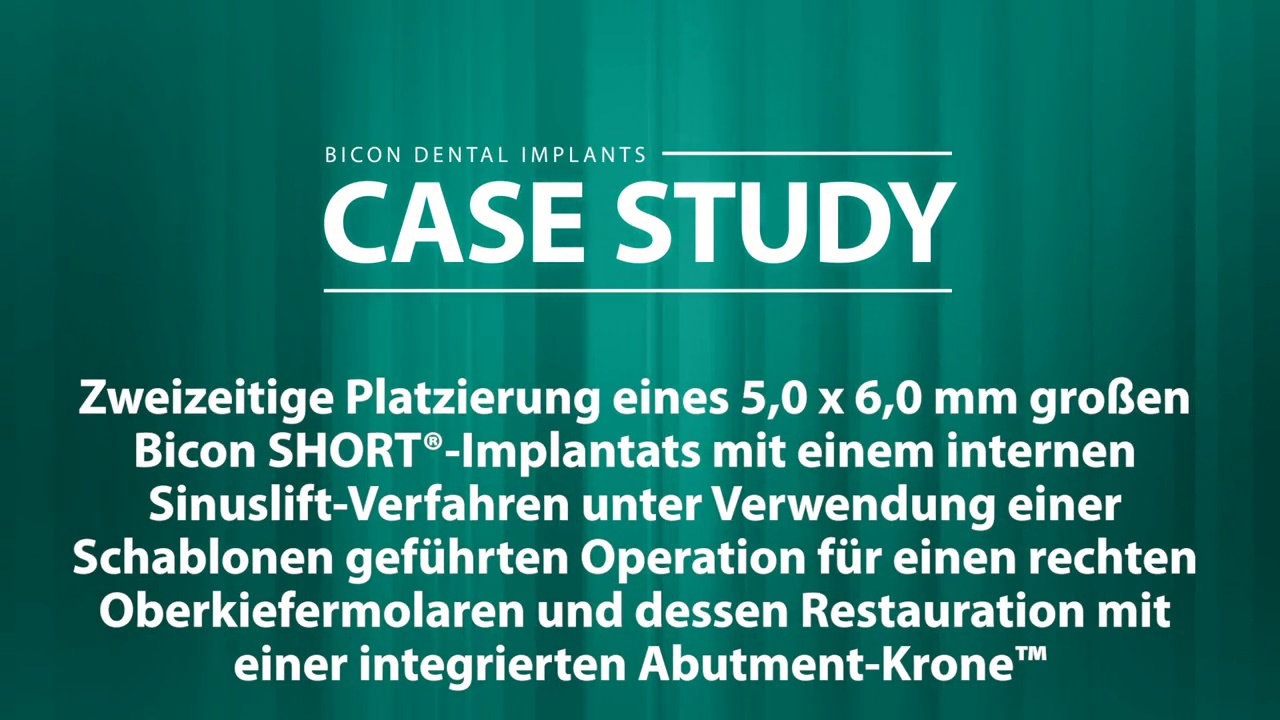
|
Zweizeitige Platzierung eines 5,0 x 6,0 mm großen Bicon SHORT®-Implantats mit einem internen Sinuslift-Verfahren unter Verwendung einer Schablonen geführten Operation für einen rechten Oberkiefermolaren und dessen Restauration mit einer integrierten Abutment-Krone ™
In diesem Fallstudienvideo wird die zweizeitige Platzierung eines 5,0 x 6,0 mm Bicon SHORT®-Implantats mit einem internen Sinuslift unter Verwendung einer „guided surgery“ für einen rechten Oberkiefermolaren und dessen Wiederherstellung mit einer „Integrated Abutment Crown ™ (IAC)“ demonstriert. Die Platzierung der geführten Operation wurde für ein 5,0 x 5,0 mm kurzes Implantat konzipiert, um das Risiko einer Sinusperforation zu minimieren und die Platzierung des 5,0 x 6,0 mm Bicon SHORT®-Implantats mit einem internen Sinuslifting zu beschleunigen. Die Osteotomie wurde dann unter Verwendung der „guided surgery Reamer“ den 5,0 mm-Guidet Ring vertieft, bis die Länge der beabsichtigten Osteotomie und Sinuselevation für das 6,0 mm-Implantat erreicht war. Darüber hinaus werden Follow-up-Bilder nach einer Woche, neun Monaten und fünf Jahren bereitgestellt. |
|---|---|

|
SHORT® Dental Implants: Does Size Really Matter? [HD]
ALL-NEW AND UPDATED FOR 2016! In this video, Dr. Bill Schaeffer of London discusses short implants, why they work, and the unique advantages they offer to the clinician. Dr. Schaeffer also conducts a review of literature and discusses his first-hand experiences with short dental implants. |

|
Immediate Placement and Loading of Four Maxillary Incisor SHORT® Implants
This case study video demonstrates the immediate placement and loading of four maxillary incisors with a TRINIA™ stabilization prosthesis, and their restoration with TRINIA™ polyceramic crowns for a 75-year-old man in four clinical visits. |

|
The Implant Book was Wrong, Longer is Not Better
In this video, Dr. Rainier Urdaneta discusses how his practice of implant dentistry changed over the years, once he recognized the merits of using 5.0 and 6.0mm short implants. He was taught to use long implants, but now knows the use of short implants is better. Short implants can avoid the need for bone grafting procedures and their associated morbity, expense, and pain. |

|
Why I Need Bicon SHORT® Implants [HD]
Follow Prof. DDr. Rolf Ewers on his journey to find a solution for building bone reliably — after 40 years of searching. After initial disbelief, he has come to the conclusion that maybe “less is more”, especially more for the patient. Rolf Ewers, MD, DMD, Ph.D. Medical University of Vienna |

|
Implant Design and Related Bone Response
In this presentation, Dr. Coelho will present his research and perspective on the factors attributing to the histology and findings of bone gain around fin and plateau designed implant systems. Paulo G. Coelho, DDS, Ph.D |

|
Clinical Evidence of the Bicon Implant
In this lecture, Dr. Urdaneta will present a series of clinical cases showing the positive effects of the Bicon locking taper implant and its use in a combination of therapies to increase bone and improve patient acceptance. Rainier Urdaneta, DMD |

|
Clinical Evidence of Bone Gain around Bicon Implants
Rainier Urdaneta, DMD Private Prosthodontic Practice |

|
Why I Need Bicon SHORT® Implants [2013]
Rolf Ewers, MD, DMD, Ph.D. Medical University of Vienna Introduction by: William H. Bell, DDS, AAOMS Life Fellow • Stowe, VT New York University • University of Texas |

|
Implant Well Diameters of the Bicon System
This video provides an introduction and explanation of Bicon’s three different implant well diameters. |